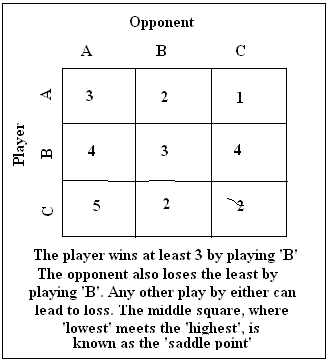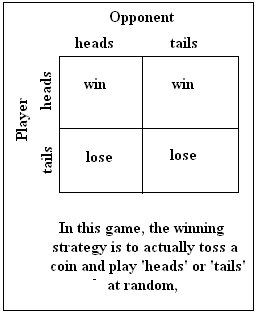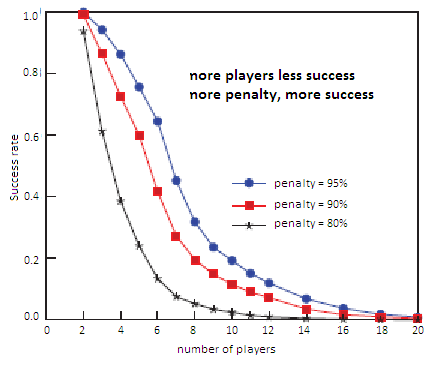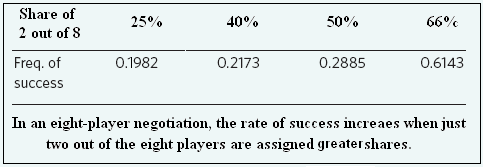Mathematics could help nations communicate and agree on reducing carbon emissions, says S.Ananthanarayanan.
The nations of the world have seen great improvement in well being and comforts over the last century, but at the cost of huge consumption of energy, and the resulting harm to the environment. In international parleys to limit carbon emissions, there is conflict of interest, with less developed nations asking to be allowed to catch up and developed nations also seeking not to be loaded with more reductions than others.
While it is correct that agreeing to reduce emissions would have economic and political consequences, not reaching an agreement would do nobody any good. The need is clearly to discover the levels of reduction where the interests of all players are best met, but the last several rounds of international conferences under the aegis of the UN have to not been able to get nations to agree to how much each one needs to do.
Rory Smead, Ronald L. Sandler, Patrick Forber and John Basl, of Northwestern and Tufts Universities in Massachusetts, in a paper in the journal, Nature Climate Change, examine the mathematical models of the interplay of nations and propose an alternative, iterative process for arriving at a stable international climate agreement.

Game theory
Game theory is the mathematical bases for players in a game, where one player wins at the cost of the other (or others), to plan their strategy. The best strategy of each player would clearly depend on the best strategy of the other player, and a player should choose moves where she maximizes gain, or minimizes loss, despite the best moves by opponents. If there is a single, best move, of both, which satisfies this condition, then they should clearly make this play all the time. But in most games, as in the market-place, there is value in being unpredictable and the best strategy is a collection of moves, to be played in some proportions, but randomly. A pay-off table, where the result of each move by either player is shown, helps work out the best strategy for each player.
And then there are bargaining games, in the simplest of which, two players need to cooperate, so that the result is better than sticking to one’s place, which would result in both being the losers. A classic example of this kind is the so called battle of the sexes, where a husband and wife have a choice between the football game and the opera, the husband likes the game and the wife the opera. They would still like to go to the same place, and need to meet at the stadium or the theatre, but cannot communicate. If they go to different places, they both lose, and if they both land up at either, then one of them is a loser. And worse is if the husband goes to the theatre, but the wife goes to the stadium, leaving both unsatisfied despite good intentions.


This game can be refined by assigning a value to the husband’s pleasure at the football game and some pleasure at the opera (pleasing the wife is not a bad thing) or the wife’s enjoyment of the opera and some interest in football too. In such cases, it turns out that the best strategy is for the husband and wife to head for one or the other place according to some proportions
The Massachusetts group .notes in the paper that for resolving the deadlock in climate negotiations, modeling has attempted to bring the various factors into classic games, like the Prisoners’ Dilemma, or some other coordination games or games of conflict. The prisoners’ dilemma is one where two criminals have been caught and the police is trying to get them to admit the crime. As neither obliges, they make them an offer – if either one confesses, but the other holds out, the one that confesses goes free but the other gets twenty years. If both confess, they both get a light sentence of one year. But if both hold out, they both go free. Each prisoner’s interest lies in confessing. If the other does not confess, the one that confesses goes free. Else, he gets one year, but he is always safe from the twenty year sentence The police hence usually solve the \case, except when the prisoners have been indoctrinated or otherwise motivated, to behave other than in the ‘rational’ way.
The Massachusetts group has made a break from this pattern, by using a version of the Nash Bargaining Game, in the simplest form of which two players make bids to .claim parts of some limited resource, say money. If the total asked for is less than what is available, they can do better and the one that asked for less is likely to raise her demand a lot. If the demand is more than what there is, then there is a penalty, and there is an incentive to reduce the demand. While earlier analyses of the climate problem looked at preferred solutions that satisfy various conditions, they did not consider the dynamics of arriving at the solutions. The Massachusetts group looked carefully at how players may adapt to each others’ behavior and the process of deciding how to change bids while bargaining, in this case, for the least emission reduction by each to reach a given total reduction goal.
Bargaining Game
The extreme case of a bargaining game is where one player is inflexible and the other must either lose everything or agree for a small share. This sometimes happens in market situations, where a larger player has more staying power. But in climate negotiations, the goal is a shared concern of reduction of total emissions and there is all round urgency in arriving at an agreement.
In the model now developed, the payoff to each player was computed as proportionate to the player’s demand, if the total demand was below the target, but with a penalty if the target was exceeded. While the traditional approach was to modify the bid, at each round of negotiations with an assumption that other players followed some fixed pattern of demand, the present model based bids on analyses of the behavior of others. |Agents would this form expectations of others’ behavior based on their earlier behavior and take this into account when they make their own bids, so as to maximize their own payoff – the best demand, in keeping with the need for total demand to stay within the target.
Computer simulations of bargaining according to this models have revealed the effects of the numbers of players, the distribution of demand and also the level of penalty fixed for not keeping within the target, on the possibility of an agreement that satisfies requirements. The target was fixed at emission reduction by 50% and success was when the players got within 1% of the target in 100 rounds of negotiations.
A first result of the simulations was that the chance of agreement drastically reduces as the number of players increases. This points to a need to reduce the number of effective players in the game, in our case by creating ‘out of court’ mergers. Thus, it would help if the number of nations was divided into groups that conducted their own negotiations and participated the UN round as single players.

The second factor was the penalty assigned to the total emissions being above target, which would amount to dissemination to all countries the cost that each one pays if the world does not agree to stay within the target. Low penalty level reduced chances of agreement, as disagreement did not lead to substantial reduction of payoff The more the comprehension and perception of the cost of not agreeing, the greater the chances of successful negotiations. It was also seen that the initial starting point was crucial – if many players started out with high demands, negotiations usually broke down. There is hence need for mechanisms to restrict initial demands, to help negotiation find a solution. Another factor that affects success was the heterogeneity of the players, or the mix of large players and small ones. This makes sense, as having more large players is effectively to have fewer players.

“Our model addresses the possibility that the problem in reaching an international climate agreement is not one concerning the existence of successful solutions but of realizing them in negotiations,” say the authors of the paper.